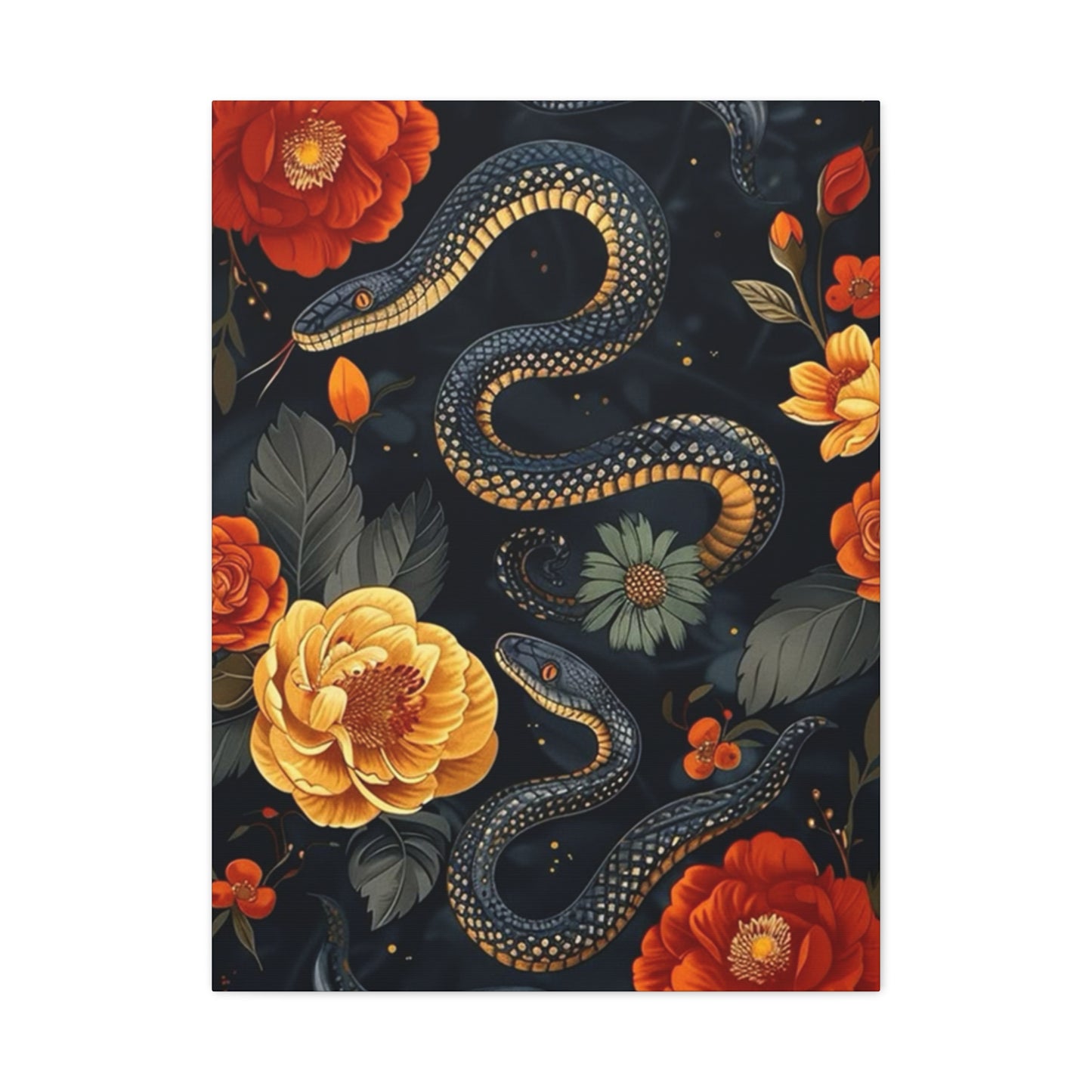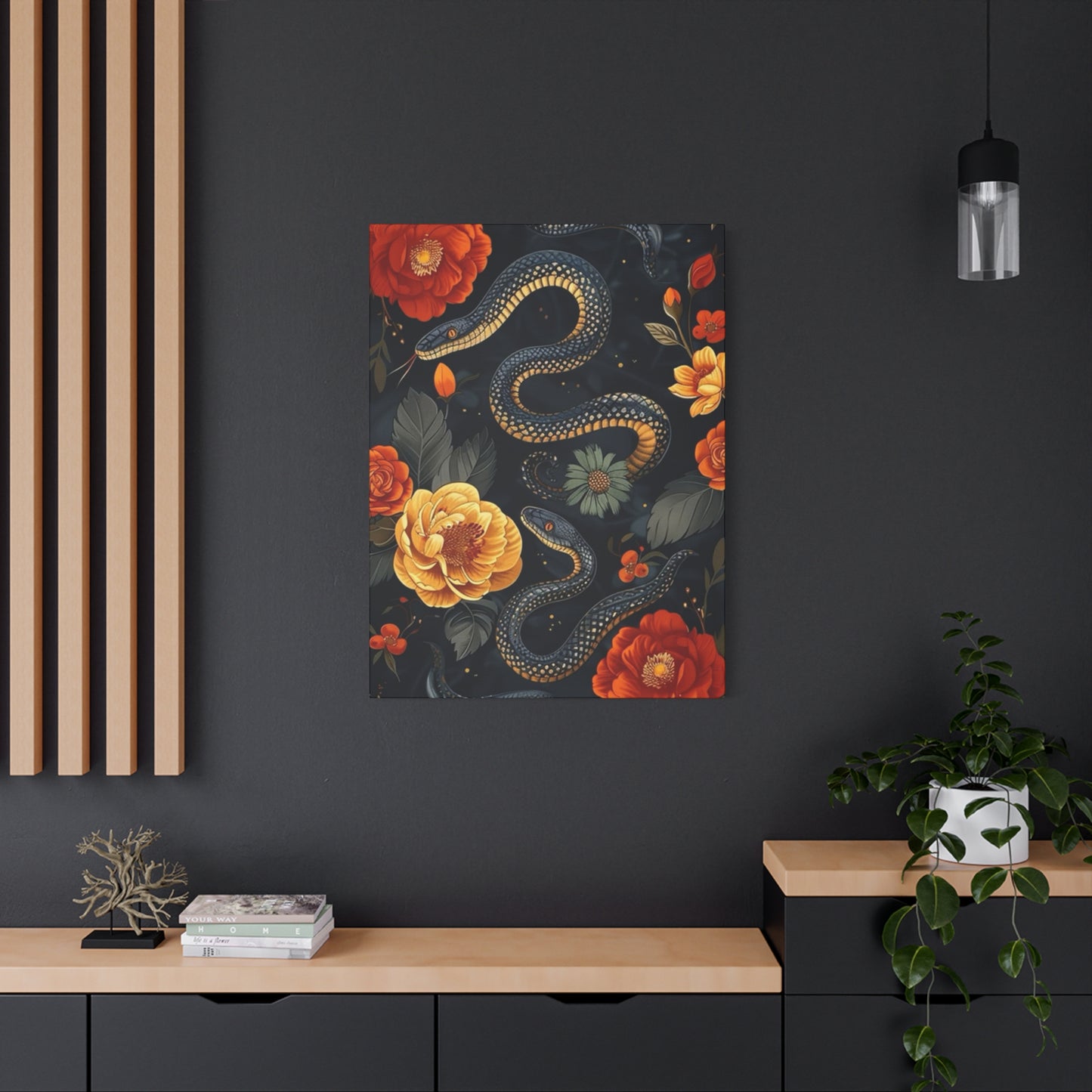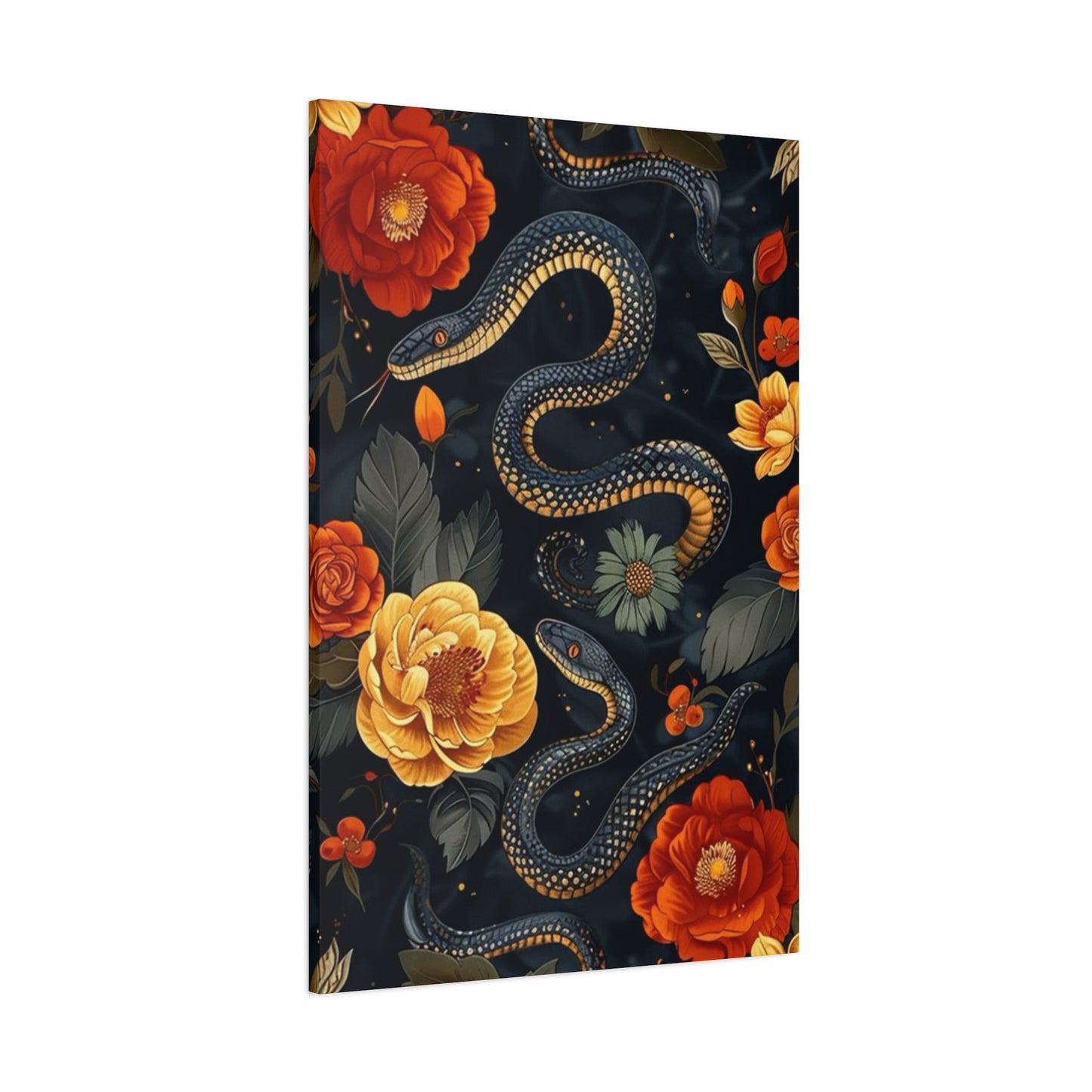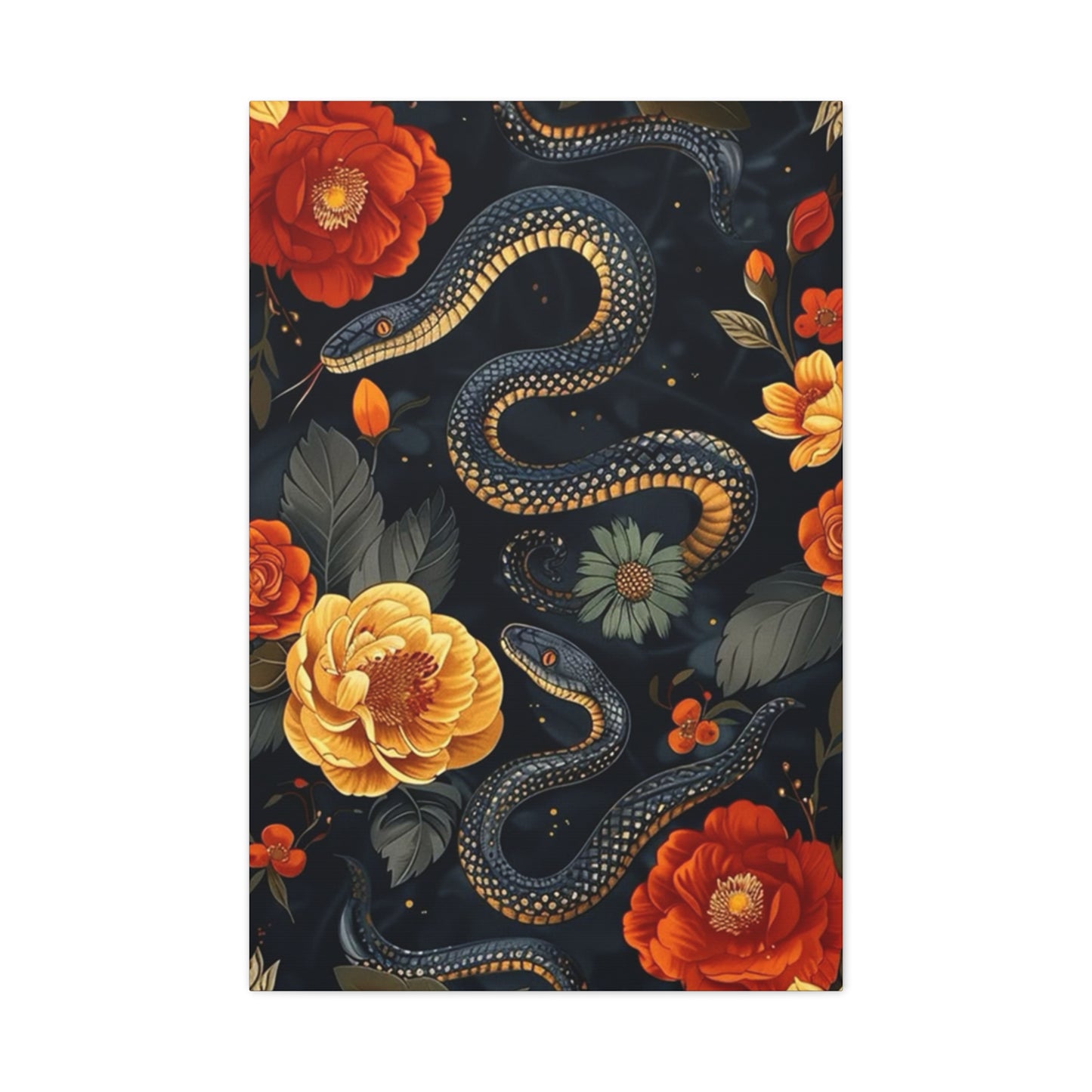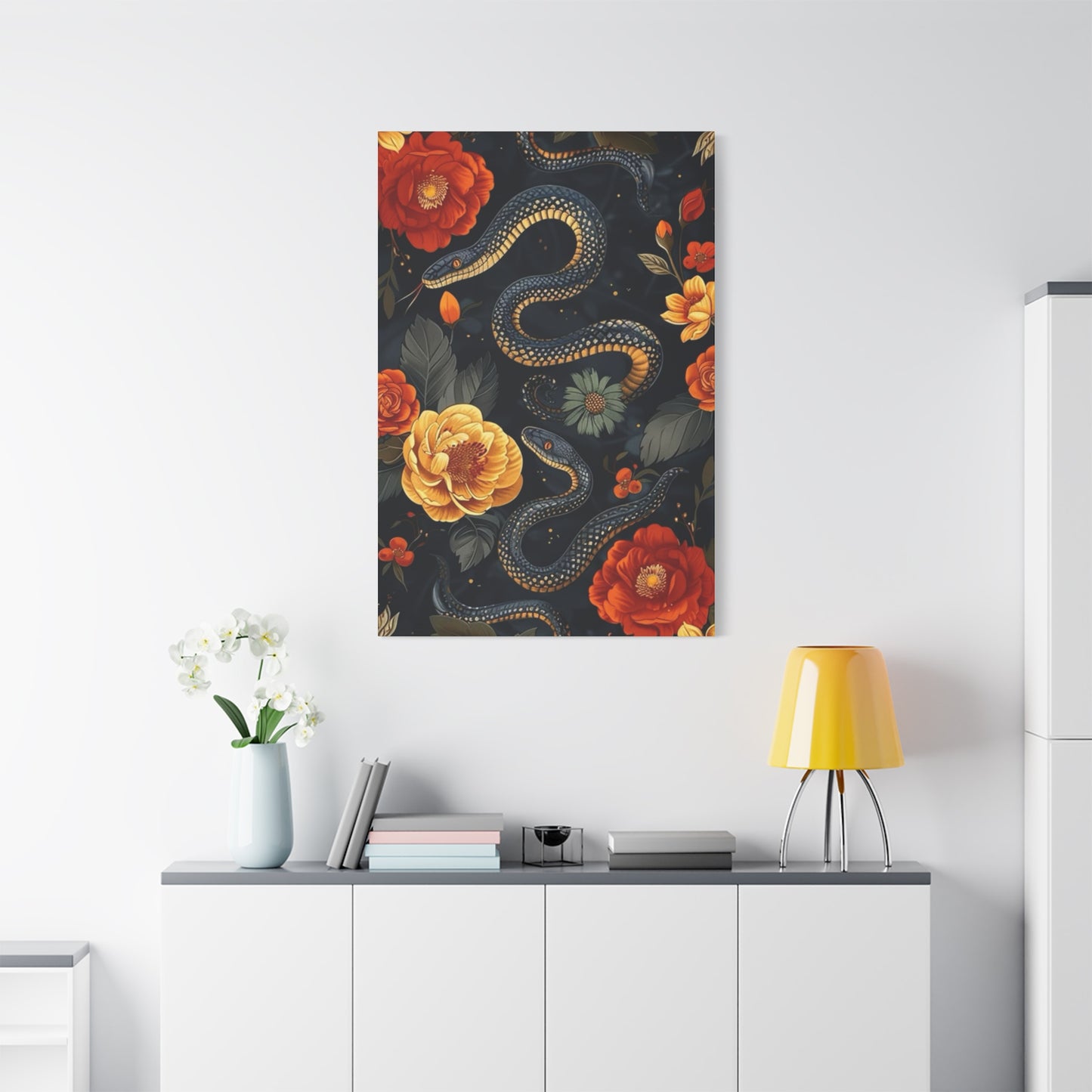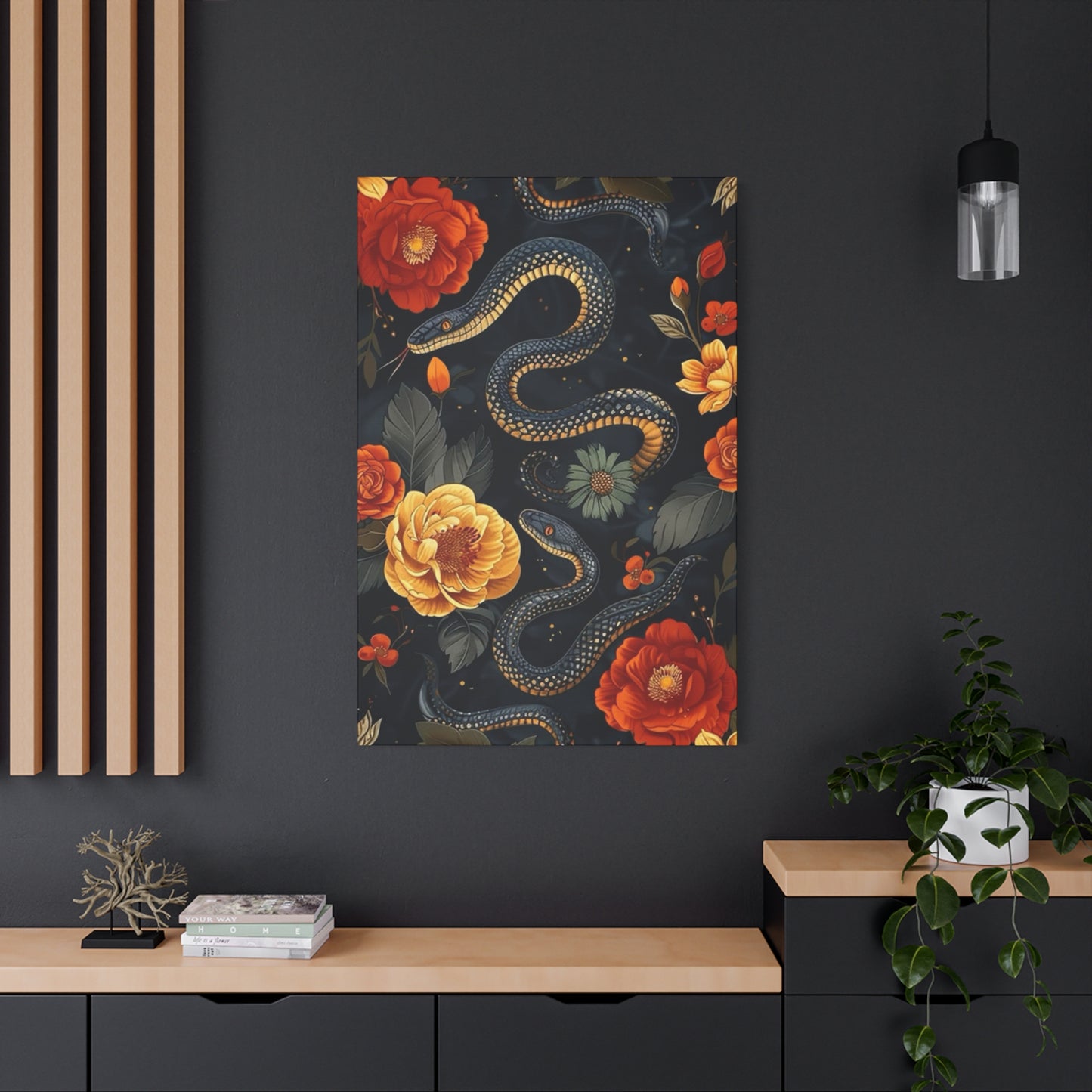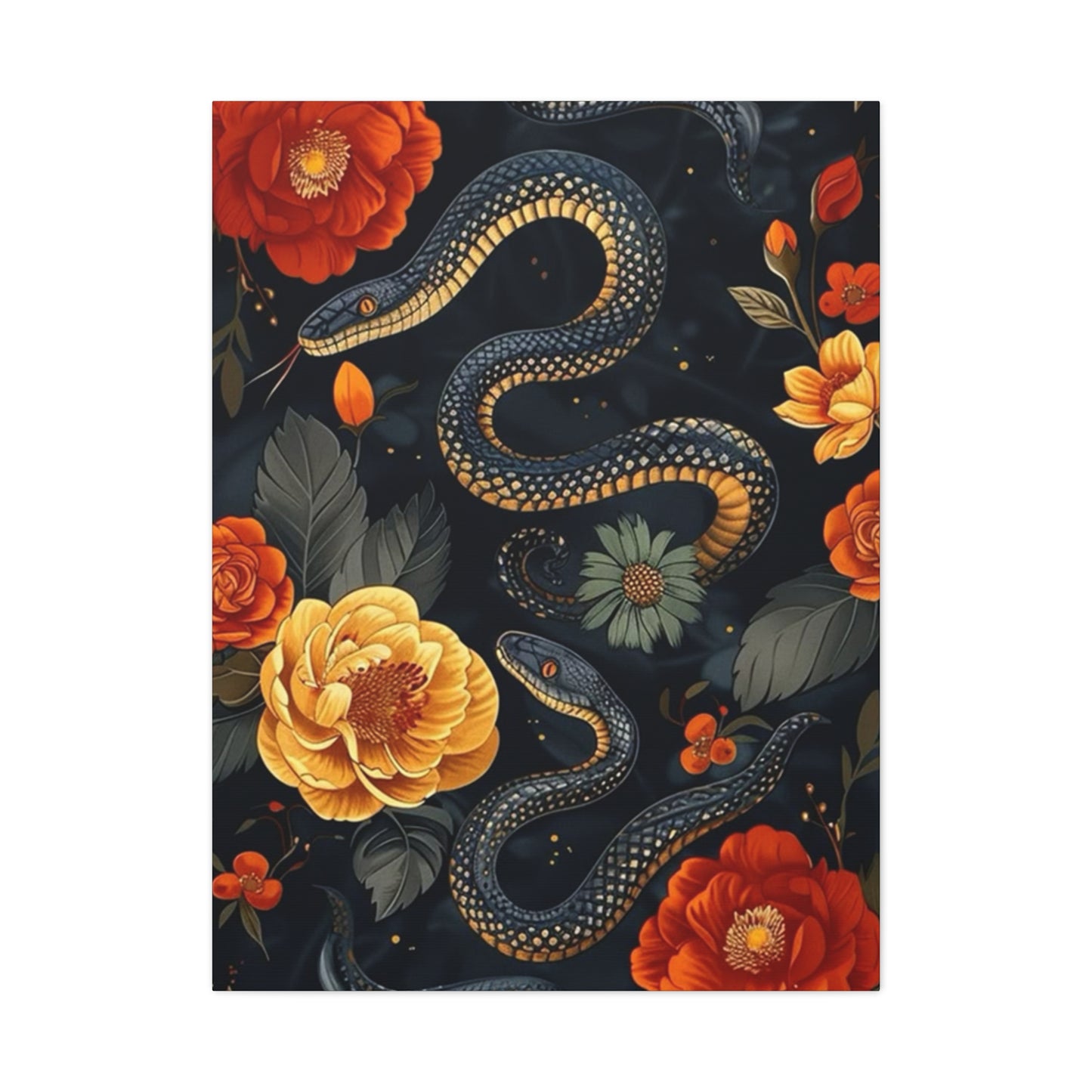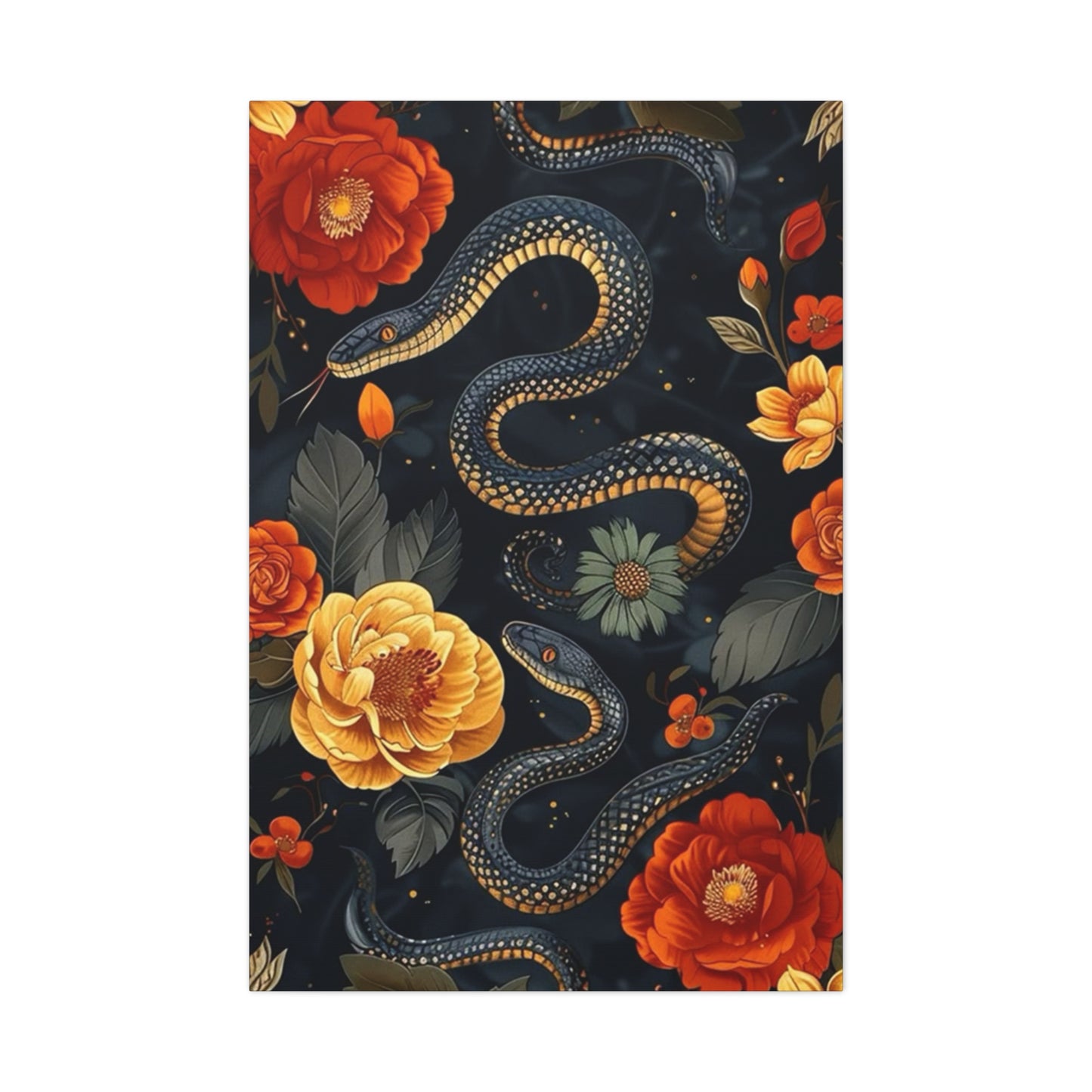Black Cobra and Flower Canvas Wall Art: Expression Through Nature's Duality
The mesmerizing combination of black cobra imagery with delicate floral elements represents one of the most compelling artistic expressions in contemporary wall art. This fascinating juxtaposition creates visual narratives that speak to the complex relationship between beauty and danger, life and death, fragility and power. Artists worldwide have embraced this theme, producing stunning canvas works that capture viewers' imagination while adding sophisticated elegance to interior spaces.
The allure of serpent and bloom artwork lies in its ability to evoke multiple emotional responses simultaneously. While flowers typically symbolize growth, renewal, and beauty, the black cobra introduces elements of mystery, power, and primal energy. This contrast creates dynamic tension within artistic compositions, making them conversation pieces that demand attention and contemplation.
Modern canvas printing techniques have revolutionized how these striking images are produced and displayed. High-quality printing methods ensure that every detail of the cobra's scales and every petal of accompanying flowers is rendered with exceptional clarity and depth. The result is artwork that maintains its visual impact whether viewed from across a room or examined closely for intricate details.
Contemporary artists approach this theme through various stylistic lenses, from photorealistic representations to abstract interpretations. Some focus on the anatomical accuracy of serpent forms, while others emphasize the emotional resonance created by the pairing of opposing natural elements. This diversity ensures that there are suitable pieces for various aesthetic preferences and interior design schemes.
The popularity of black cobra and flower canvas art extends beyond mere decoration. These pieces often serve as focal points in rooms, anchoring color schemes and establishing atmospheric moods. The predominantly dark palette of most cobra imagery provides versatility in decorating, as these pieces complement both light and dark interior themes while adding depth and sophistication to any space.
Artistic Styles and Creative Approaches
Abstract cobra and flower canvas designs push the boundaries of traditional representation, transforming recognizable forms into fluid, interpretive expressions. These works often employ bold brushstrokes, dramatic color contrasts, and geometric elements to suggest rather than directly depict their subjects. Artists working in this style might use the sinuous curves of a cobra's body as a starting point for exploring movement and rhythm within the composition, while floral elements become bursts of color and texture that punctuate the flowing lines.
The beauty of abstract interpretation lies in its ability to engage viewers' imagination. Rather than presenting a literal scene, these works invite personal interpretation and emotional response. Color choices become particularly significant in abstract pieces, with artists using warm and cool tones to create temperature contrasts that enhance the inherent tension between serpent and flower imagery.
Layering techniques are frequently employed in abstract cobra art, with artists building up surfaces through multiple applications of paint, creating rich textures that catch and reflect light differently throughout the day. This approach ensures that the artwork continues to reveal new details and aspects as lighting conditions change, making it a dynamic addition to any interior space.
Many abstract artists incorporate mixed media elements into their cobra and flower compositions, adding materials like metallic paints, textured gels, or even three-dimensional elements that extend beyond the canvas surface. These additions create artwork that engages multiple senses and adds sculptural qualities to what might otherwise be purely two-dimensional pieces.
The scale of abstract cobra artwork varies considerably, from intimate pieces suitable for personal spaces to large installations designed to command attention in public areas. Artists often create series of related works that can be displayed together, allowing viewers to experience variations on the theme while maintaining cohesive visual relationships between pieces.
Minimalist black cobra wall art represents a stark departure from more elaborate compositions, focusing on essential elements to create maximum visual impact. This approach strips away unnecessary details, concentrating on the fundamental forms and relationships that make cobra imagery compelling. The result is artwork that achieves elegance through restraint rather than elaboration.
Color palettes in minimalist cobra art typically employ limited ranges, often working within monochromatic schemes that emphasize form over chromatic complexity. Black, white, and various shades of gray dominate these compositions, with occasional strategic uses of accent colors to highlight specific elements or create focal points within the overall design.
Negative space plays a crucial role in minimalist compositions, with artists using empty areas as active design elements rather than simply backgrounds. The careful balance between positive and negative space creates visual tension and helps guide viewers' eyes through the composition in deliberate ways.
Line quality becomes paramount in minimalist cobra art, with every mark carrying significant visual weight. Artists must carefully consider the character of each line, whether it should be bold and confident or delicate and subtle. These decisions directly impact the emotional resonance of the finished piece and its ability to communicate the intended message or mood.
The compositional challenge in minimalist work lies in conveying the essential characteristics of both cobra and floral elements using only the most necessary visual information. This requires artists to distill complex forms into their most recognizable and emotionally resonant aspects, creating works that are simultaneously simple and sophisticated.
Watercolor Techniques and Floral Integration
Watercolor cobra and floral paintings bring a unique softness to what might otherwise be stark subject matter. The translucent nature of watercolor medium allows artists to create layers of meaning through overlapping washes of color, building depth and complexity gradually. This technique is particularly effective when depicting the interplay between serpentine forms and delicate flower petals.
The fluid nature of watercolor naturally complements the organic curves of cobra bodies, allowing artists to capture the sense of movement and flexibility that characterizes these creatures. Paint flows and bleeds create natural variations in tone and texture that can suggest scales, shadows, and the play of light across serpentine surfaces without requiring detailed rendering of every individual element.
Floral elements in watercolor cobra paintings often serve as counterpoints to the more structured serpent forms. Artists can use wet-on-wet techniques to create soft, impressionistic blooms that seem to emerge from or dissolve into the surrounding composition. This approach creates visual poetry that speaks to themes of transformation and the cycles of nature.
Color mixing becomes particularly important in watercolor cobra and flower paintings, as the medium's transparent nature means that underlying colors continue to influence the overall appearance even after additional layers are applied. Artists must carefully plan their color relationships to ensure that the final result maintains harmony while preserving the dramatic contrasts that make this subject matter compelling.
The unpredictability of watercolor can be both challenging and advantageous when working with cobra and flower themes. Happy accidents in paint flow and color interaction can suggest natural textures and organic relationships that would be difficult to achieve through more controlled techniques. Experienced artists learn to work with these spontaneous effects, incorporating them into their compositional strategies.
Realistic versus stylized cobra canvas art presents viewers with fundamentally different experiences and serves different decorative purposes. Realistic depictions focus on anatomical accuracy, detailed rendering of scales, and faithful representation of natural colors and patterns. These works often function as educational pieces as well as decorative ones, allowing viewers to appreciate the intricate beauty of actual cobra species.
The challenge in realistic cobra art lies in capturing not just the physical appearance of these creatures but also their essential character and presence. Artists must understand reptilian anatomy, scale patterns, and the way light interacts with serpentine surfaces to create convincing representations that maintain visual interest without becoming mere scientific illustrations.
Stylized approaches, by contrast, take creative liberties with natural forms to serve artistic purposes. These works might exaggerate certain characteristics, employ unusual color schemes, or incorporate fantastical elements that enhance the mythological associations many cultures have with serpents. Stylized pieces often prove more versatile in decorating applications, as they can be adapted to complement specific color schemes or design themes.
The choice between realistic and stylized approaches often depends on the intended use and audience for the artwork. Realistic pieces might appeal more strongly to nature enthusiasts or those seeking educational value in their art, while stylized works might better serve purely decorative purposes or fit into specific design schemes.
Both approaches can incorporate floral elements effectively, though the treatment of flowers often follows the same philosophical approach as the serpent depiction. Realistic works might feature botanically accurate flowers, while stylized pieces might employ abstract or fantastical floral forms that serve compositional rather than representational purposes.
Ink Illustration and Print Techniques
Ink illustration black cobra prints offer a distinctive aesthetic that combines the precision of line work with the dramatic impact of monochromatic imagery. This medium allows artists to create intricate details while maintaining strong graphic impact, making these works particularly effective as statement pieces in contemporary interiors.
The versatility of ink as a medium enables artists to achieve a wide range of effects, from delicate stippling that suggests texture and shadow to bold, confident strokes that define major forms and establish compositional structure. Cross-hatching techniques can create rich tonal variations without requiring color, while solid black areas provide dramatic contrasts that anchor compositions visually.
Pen and ink work requires careful planning, as corrections are often impossible once marks are made. This constraint encourages thoughtful composition and confident execution, resulting in works that often possess a spontaneous energy despite their calculated construction. The permanence of ink marks also means that every line contributes to the final impact of the piece.
Modern printing techniques have made it possible to reproduce ink illustrations with exceptional fidelity, preserving the subtle variations in line weight and texture that give hand-drawn work its character. High-quality prints can capture even the finest details of cross-hatching and stippling, ensuring that the artist's original intentions are preserved in the final canvas presentation.
The graphic nature of ink illustrations makes them particularly suitable for contemporary and modern interior design schemes. These works complement clean lines and minimalist aesthetics while providing visual interest through their intricate detail work. The monochromatic nature of most ink work also ensures easy integration with existing color schemes.
Contemporary artists working in ink often combine traditional techniques with digital tools, using computer software to enhance or modify hand-drawn elements. This hybrid approach allows for greater experimentation while preserving the essential character of ink illustration. Digital techniques can also facilitate the creation of series or variations on themes, enabling artists to explore multiple approaches to the same subject matter.
Interior Design Integration and Spatial Considerations
Feng shui-inspired cobra wall art represents a fascinating intersection of ancient philosophical principles and contemporary artistic expression. In feng shui practice, serpent imagery can symbolize wisdom, transformation, and the flow of energy through spaces. When combined with floral elements, these artworks can represent the balance between different natural forces and the harmony between opposing elements.
The placement of cobra and flower artwork within a space requires careful consideration of feng shui principles. These pieces are often most effective when positioned in areas associated with personal transformation or spiritual growth, such as meditation spaces or study areas. The specific direction and height of placement can influence the energy flow within a room, making it important to consider these factors during installation.
Color choices in feng shui-inspired cobra art often follow traditional associations, with black representing water energy and mystery, while floral colors might represent wood energy and growth. The interaction between these color energies can create dynamic relationships within a space, influencing the overall atmospheric quality of the environment.
The size and scale of feng shui-inspired artwork should be proportional to the space it occupies, neither overwhelming the room nor becoming lost within it. The goal is to create pieces that enhance the energy flow of a space rather than disrupting it, requiring careful attention to the relationship between artwork dimensions and room proportions.
Many feng shui practitioners recommend incorporating natural elements into cobra and flower artwork, such as representations of water, earth, or sky. These additions help connect the artwork to broader natural cycles and energy patterns, enhancing its ability to influence the spatial environment positively.
Dark and moody cobra canvas for bedrooms requires special consideration of how these powerful images will affect the psychological atmosphere of intimate spaces. While cobra imagery can be dramatic and striking, the bedroom application requires careful attention to color choices and compositional elements that promote rest and relaxation rather than stimulation or anxiety.
Deep, rich colors often work well in bedroom cobra art, as they can create sophisticated atmospheres without being overly stimulating. Navy blues, deep purples, and rich browns can provide dramatic backgrounds for serpent and floral imagery while maintaining the calming qualities necessary for bedroom environments.
The scale of bedroom cobra artwork should be appropriate for intimate viewing distances, as these pieces will often be observed from close range. This proximity allows for inclusion of intricate details and subtle color variations that might be lost in larger spaces, making bedroom pieces ideal for showcasing technical skill and artistic refinement.
Lighting considerations become particularly important for bedroom cobra art, as these pieces need to work effectively under both natural daylight and artificial evening illumination. The interplay between artwork and lighting can dramatically affect the mood of a bedroom, making it essential to test pieces under various lighting conditions before final placement.
The psychological impact of cobra imagery in bedrooms should be carefully considered, as some individuals might find serpent imagery disturbing or stimulating rather than calming. For these situations, artists often emphasize the more positive symbolic associations of snakes, such as wisdom, healing, or transformation, while de-emphasizing more threatening aspects of serpent imagery.
Statement Pieces and Living Room Integration
Bold statement pieces for living rooms require artwork that can command attention while remaining visually comfortable for extended viewing periods. Cobra and flower canvas art serves this purpose exceptionally well, as the inherent drama of the subject matter creates immediate visual impact while the complexity of well-executed pieces rewards closer examination and continued viewing.
The living room placement allows for larger scale works that can be appreciated from multiple viewing distances and angles. This flexibility enables artists to create complex compositions that reveal different aspects depending on viewing position, making the artwork an active participant in the room's changing dynamics throughout the day.
Color coordination with existing decor becomes crucial when selecting cobra art for living spaces. The predominantly dark palette of most cobra imagery provides a sophisticated backdrop that can anchor brighter accent colors in furniture and accessories. Alternatively, cobra art with strategic color accents can serve as the inspiration for entire room color schemes.
The social nature of living spaces means that cobra and flower artwork will frequently be viewed and discussed by visitors, making it important to select pieces that can sustain repeated viewing and generate positive responses. The symbolic richness of serpent and floral imagery often provides excellent conversation starters while demonstrating the owner's appreciation for sophisticated artistic themes.
Lighting design becomes particularly important for living room cobra art, as these spaces typically require versatile illumination for different activities and times of day. Artwork lighting should enhance the visual impact of the pieces while contributing to the overall ambiance of the space, often requiring specialized picture lighting or strategic placement relative to existing light sources.
Botanical and snake art for modern homes represents a growing trend in contemporary interior design, reflecting increased interest in biophilic design principles that emphasize connections to natural world. This approach recognizes that representations of natural forms can positively influence psychological well-being and create more comfortable, engaging living environments.
The modern aesthetic typically favors clean lines and uncluttered compositions, making it important to select cobra and flower artwork that complements rather than conflicts with contemporary design principles. This might involve choosing pieces with simplified forms, strategic use of negative space, and color palettes that harmonize with modern furniture and architectural elements.
Scale relationships become particularly important in modern interiors, where large, unbroken wall surfaces are common. Cobra and flower artwork can serve as architectural elements in these contexts, helping to define spaces and create visual anchors within otherwise minimal environments. The organic curves of serpent forms can provide welcome contrast to the geometric lines typical of modern architecture.
The integration of technology in modern homes also affects artwork selection, as pieces need to work effectively with various forms of artificial lighting and potentially compete with screens and other digital displays for visual attention. Cobra and flower art with strong compositional structure and clear focal points often performs well in these challenging visual environments.
Mixing Animal and Floral Motifs
Mixing animal art with floral decor creates layered visual narratives that can transform ordinary rooms into sophisticated, emotionally engaging spaces. The combination of cobra imagery with various floral elements allows for exploration of themes ranging from the cycles of nature to the relationship between beauty and danger, providing rich material for interior design storytelling.
The key to successful integration lies in understanding the visual relationships between different artistic elements and how they can be combined to create harmonious overall effects. This might involve selecting floral pieces that echo the color palette of cobra artwork, or choosing serpent images that complement the scale and style of existing botanical art.
Repetition of visual elements can help create coherence when mixing different types of nature-themed artwork. This might involve repeating certain colors across multiple pieces, using similar compositional structures, or maintaining consistent levels of detail and rendering style throughout a collection of works.
The seasonal rotation of artwork can add dynamic interest to mixed animal and floral displays, allowing homeowners to emphasize different aspects of their collections throughout the year. Spring displays might emphasize renewal and growth themes, while autumn arrangements could focus on transformation and change, with cobra imagery playing different symbolic roles in each seasonal context.
Professional framing and presentation become particularly important when mixing different types of artwork, as consistent presentation can help unify diverse pieces while inappropriate framing choices can create visual discord. The selection of frame styles, mat colors, and presentation formats should support the overall design vision while respecting the individual character of each piece.
The psychological impact of combined animal and floral imagery can be quite powerful, as viewers respond to both the individual elements and their relationships. Cobra and flower combinations can evoke complex emotional responses that single-theme artworks might not achieve, making these mixed approaches particularly effective for creating memorable and engaging interior environments.
Symbolic Interpretations and Cultural Meanings
Black cobra as a symbol of transformation represents one of the most powerful and universal symbolic associations found in human culture. Across many civilizations, serpents have represented renewal, rebirth, and the cyclical nature of life, with the shedding of skin serving as a powerful metaphor for personal growth and spiritual development. When combined with floral imagery, these themes become even more complex and meaningful.
The color black adds additional layers of symbolic meaning to cobra imagery, often representing mystery, the unknown, and the hidden aspects of experience. In many spiritual traditions, black is associated with the fertile darkness from which new life emerges, making black cobra imagery particularly appropriate for spaces dedicated to contemplation, creativity, or personal reflection.
Different cultures have varying relationships with serpent symbolism, and these cultural associations can significantly influence how cobra artwork is received and interpreted. In some traditions, serpents are associated with healing and medicine, while others emphasize their role as guardians or protectors of sacred knowledge. Understanding these cultural contexts can help in selecting and presenting cobra art appropriately.
The transformation theme inherent in cobra symbolism makes these artworks particularly meaningful for individuals undergoing significant life changes or seeking personal growth. The presence of such powerful symbolic imagery in living spaces can serve as daily reminders of the possibility for renewal and positive change, making them more than merely decorative elements.
Contemporary artists often consciously engage with traditional serpent symbolism while adding their own interpretations and meanings. This layering of historical and personal significance creates artwork that operates on multiple levels, appealing both to viewers familiar with traditional associations and those responding primarily to visual and emotional impact.
Floral contrasts exploring life and danger in art create fascinating visual and conceptual tensions that engage viewers on multiple levels. The juxtaposition of delicate, beautiful flowers with powerful, potentially dangerous serpents speaks to fundamental aspects of natural existence, where beauty and danger often coexist in complex relationships.
The concept of memento mori, or reminders of mortality, finds expression in cobra and flower artwork through the contrast between blooming life and predatory danger. This theme has deep roots in artistic tradition, with many cultures using similar contrasts to explore philosophical questions about the nature of existence and the relationship between different aspects of natural experience.
Color symbolism plays a crucial role in expressing these contrasts, with artists using warm, bright colors for floral elements to represent life and vitality, while employing darker, cooler tones for serpent imagery to suggest mystery, power, or potential threat. The interaction between these color relationships creates visual dynamics that reinforce conceptual themes.
The temporal aspects of both flowers and serpents add another layer of meaning to these artistic contrasts. Flowers represent the ephemeral nature of beauty and life, blooming briefly before fading, while serpents embody continuity and survival, creatures that have remained largely unchanged for millions of years. This tension between the temporary and the eternal provides rich material for artistic exploration.
Contemporary environmental concerns add new dimensions to traditional life and danger themes in cobra and flower art. As natural habitats face increasing pressures, artwork celebrating the beauty and power of wild creatures and plants can serve as both aesthetic objects and subtle environmental statements, encouraging viewers to consider their relationships with the natural world.
Spiritual and Mythological Dimensions
Spiritual meanings behind cobra wall art draw from diverse religious and philosophical traditions that have recognized serpents as important spiritual symbols throughout human history. In many Eastern traditions, serpents represent kundalini energy, the spiritual force that lies dormant within individuals until awakened through spiritual practice, making cobra imagery particularly appropriate for meditation spaces and areas dedicated to spiritual growth.
The medical profession has long used serpent imagery in the caduceus symbol, associating snakes with healing and renewal. This connection stems from observations of serpents shedding their skin, which has been interpreted as a metaphor for healing and regeneration. Cobra art incorporating healing themes can be particularly meaningful in spaces dedicated to wellness and recovery.
Ancient Egyptian mythology elevated cobras to divine status, with the cobra goddess Wadjet serving as protector of the pharaohs and guardian of Lower Egypt. This protective aspect of cobra symbolism makes these artworks potentially meaningful as guardian images for homes and personal spaces, serving both decorative and spiritual protective functions.
The ouroboros symbol, depicting a serpent eating its own tail, represents eternal cycles, self-renewal, and the interconnectedness of all things. Artists working with cobra themes often reference this ancient symbol, creating works that explore themes of continuity, transformation, and the cyclical nature of existence.
Contemporary spiritual movements often embrace serpent symbolism for its associations with wisdom, intuition, and access to hidden knowledge. Cobra artwork in these contexts serves not merely as decoration but as focal points for meditation and spiritual contemplation, helping to create atmospheres conducive to introspection and spiritual growth.
Nature's duality expressing predators and flowers in artistic form speaks to fundamental tensions within natural systems, where beauty and danger, creation and destruction, growth and death exist in constant dynamic relationship. This duality provides rich material for artistic exploration and personal reflection on the complex nature of existence itself.
The predator-prey relationships that exist in nature find artistic expression through the juxtaposition of serpent and floral imagery, with flowers potentially representing vulnerability and innocence while cobras embody power and potential threat. These relationships can be explored through various artistic approaches, from literal depictions to abstract interpretations.
The ecological reality that predators play essential roles in maintaining healthy ecosystems adds depth to artistic explorations of natural duality. Cobra imagery in this context can represent necessary balance rather than simple threat, encouraging viewers to consider more complex relationships between different aspects of natural systems.
Seasonal cycles provide another framework for understanding natural duality, with flowers representing spring growth and renewal while serpents might symbolize the dormant power that enables survival through difficult periods. Artists can explore these seasonal themes through color choices, compositional elements, and symbolic references.
The philosophical concept of yin and yang finds natural expression in cobra and flower imagery, with each element representing different but complementary aspects of natural existence. This balance between opposing forces creates visual and conceptual harmony that can be deeply satisfying for viewers seeking art that reflects their understanding of natural relationships.
Mythological and Cultural Inspirations
Mythical inspirations for snake-themed art draw from a rich global heritage of serpent legends, mythologies, and cultural traditions that have developed over thousands of years. These stories provide contemporary artists with powerful symbolic vocabulary and narrative frameworks that can add depth and meaning to visual compositions featuring cobra and floral elements.
Greek mythology presents numerous serpent figures, from the healing serpents associated with Asclepius to the dangerous Medusa with her serpentine hair. These mythological references can provide thematic frameworks for contemporary cobra art, allowing artists to engage with classical themes while creating works relevant to modern audiences and interior spaces.
Hindu and Buddhist traditions offer particularly rich serpent symbolism, with Nagas representing wisdom, fertility, and the connection between earthly and divine realms. Cobra artwork inspired by these traditions might incorporate lotus flowers or other sacred plants, creating pieces that function as both decorative art and spiritual focal points.
Norse mythology features the World Serpent Jormungandr, whose enormous coils encircle the entire world, representing the interconnectedness of all existence and the cyclical nature of time. Contemporary artists might reference this mythological framework when creating large-scale cobra installations or series of related works.
Mesoamerican cultures produced elaborate serpent mythology, with Quetzalcoatl representing the union of earth and sky, matter and spirit. The feathered serpent imagery from these traditions can inspire contemporary artworks that combine cobra forms with elaborate floral or decorative elements, creating pieces that celebrate both natural beauty and spiritual significance.
African serpent mythologies often emphasize the protective and fertility aspects of snake symbolism, with serpents serving as guardians of sacred spaces and sources of life-giving water. These cultural associations can inform contemporary cobra art intended for spaces where protection and nurturing are important themes.
Seasonal and Thematic Applications
Halloween-inspired black cobra prints tap into the seasonal appetite for mysterious and slightly threatening imagery while maintaining sophisticated artistic standards. These works often emphasize the more dramatic and mysterious aspects of cobra imagery, using deep shadows, stark contrasts, and atmospheric effects to create pieces that enhance Halloween decorating schemes without resorting to cartoon-like imagery.
The color palette for Halloween cobra art typically emphasizes deep blacks, rich purples, and dramatic oranges, colors that evoke autumn and mystery while providing striking visual impact. These works often incorporate gothic or horror-inspired aesthetic elements while maintaining the artistic sophistication that makes them suitable for adult decorating sensibilities.
Floral elements in Halloween cobra art might include autumn flowers like chrysanthemums, or more exotic blooms like black roses or dark orchids that enhance the mysterious atmosphere. These botanical elements can provide color accents and textural interest while supporting the overall seasonal theme.
The temporary nature of Halloween decorating allows for more experimental and dramatic artistic choices than might be appropriate for year-round display. This seasonal context enables artists to explore darker themes and more intense visual approaches while creating works that serve specific decorative purposes.
Lighting considerations become particularly important for Halloween cobra art, as these pieces often rely on dramatic shadow effects and atmospheric qualities that require specific illumination to achieve maximum impact. The interaction between artwork and lighting can significantly enhance the seasonal effectiveness of these pieces.
Autumn wall decor with snake motifs celebrates the seasonal themes of transformation, preparation for dormancy, and the beauty found in decline and change. Cobra imagery works particularly well in autumn contexts, as serpents naturally prepare for winter dormancy, making them appropriate symbols for seasonal transition and preparation.
The color palette of autumn cobra art typically emphasizes warm earth tones, rich browns, deep oranges, and golden yellows that echo the changing foliage and seasonal atmosphere. These colors can be incorporated both in the cobra imagery itself and in accompanying floral elements, creating cohesive seasonal compositions.
Autumn floral elements might include maple leaves, oak branches, dried flowers, or seed pods that reference the seasonal cycle of growth, maturity, and preparation for dormancy. These botanical elements can provide textural interest and seasonal relevance while maintaining artistic sophistication.
The psychological associations of autumn with introspection, preparation, and quiet contemplation make cobra art particularly appropriate for this season, as serpent symbolism often relates to wisdom, patience, and inner transformation. These thematic connections can add depth to autumn decorating schemes.
The transitional nature of autumn makes it an ideal time to introduce new artwork or rotate seasonal displays, with cobra and autumn botanical imagery providing sophisticated alternatives to more conventional fall decorating approaches.
Exotic and Mystical Themes
Exotic jungle theme with cobra and flowers creates immersive decorative environments that transport viewers to imagined tropical landscapes filled with danger and beauty. These artistic approaches often emphasize lush vegetation, dramatic lighting effects, and the sense of mysterious life hidden within dense foliage, with cobra imagery serving as focal points within complex natural scenes.
The color palette for jungle-themed cobra art typically employs rich greens, deep browns, and brilliant tropical flower colors that suggest the abundance and intensity of rainforest environments. Artists might incorporate multiple shades of green to suggest different types of vegetation, while using bright accent colors for exotic flowers that punctuate the composition.
Layering becomes particularly important in jungle-themed compositions, with artists creating depth through overlapping forms, varied focus levels, and atmospheric perspective effects. This approach helps create the sense of dense, mysterious environments where cobra forms might emerge from or disappear into surrounding vegetation.
The inclusion of other tropical elements like orchids, bird of paradise flowers, or exotic foliage can enhance the jungle theme while providing opportunities for color variety and textural contrast. These additional elements help create rich, immersive compositions that reward detailed examination.
The scale and format of jungle-themed cobra art often favors larger works or multi-panel installations that can create more immersive visual experiences. These larger formats allow artists to develop complex environmental compositions that might not be possible within smaller, single-panel constraints.
Mystical and magical wall art for fall combines the seasonal associations of autumn with supernatural and spiritual themes, creating artwork that celebrates both natural cycles and metaphysical concepts. Cobra imagery fits naturally into mystical themes, with serpents traditionally associated with hidden knowledge, spiritual transformation, and access to supernatural powers.
The incorporation of mystical symbols like pentacles, crystals, celestial bodies, or runic characters can enhance the magical atmosphere of cobra artwork while providing additional visual interest and symbolic depth. These elements should be integrated thoughtfully to support rather than overwhelm the primary serpent and floral imagery.
Color choices for mystical autumn cobra art often emphasize deep purples, midnight blues, and rich burgundies that suggest mystery and magic while maintaining seasonal relevance. Metallic accents in gold, silver, or copper can add mystical glamour and suggest supernatural energies.
The lighting and atmospheric effects in mystical cobra art often emphasize drama and mystery, with artists using techniques like rim lighting, dramatic shadows, or suggested supernatural illumination to enhance the magical qualities of their compositions.
The symbolic content of mystical cobra art might reference various spiritual and magical traditions, from Wiccan nature worship to Eastern spiritual practices, allowing viewers to connect with artwork that reflects their personal spiritual interests and beliefs.
Botanical Integration and Summer Themes
Summer botanical art featuring serpents celebrates the peak growing season when both plant and animal life reaches maximum activity and visibility. This seasonal context allows for the incorporation of lush summer flowers, full foliage, and the sense of abundant natural energy that characterizes the warmest months of the year.
The color palette for summer cobra and botanical art typically emphasizes bright, saturated colors that reflect the intensity of summer light and the abundance of blooming plants. Brilliant reds, vibrant yellows, and rich blues can represent various summer flowers, while maintaining the dramatic impact of cobra imagery through strategic use of darker tones and contrasts.
Summer flowers like roses, sunflowers, lilies, or tropical blooms provide excellent companions for cobra imagery, as these plants often possess their own dramatic qualities that complement rather than compete with serpent forms. The scale and structure of summer flowers can also provide interesting compositional counterpoints to the linear qualities of snake imagery.
The increased daylight hours of summer affect how artwork is viewed and experienced, with pieces needing to work effectively under bright natural illumination as well as evening artificial lighting. This lighting variability can be used to advantage, with artists creating works that reveal different qualities under different illumination conditions.
The active nature of summer outdoor life means that cobra and botanical art for this season often needs to compete with windows, outdoor views, and the general visual excitement of the season. This context favors bold, confident artistic approaches that can maintain visual impact within stimulating environmental contexts.
The psychological associations of summer with energy, growth, and activity make cobra imagery particularly interesting in this seasonal context, as serpents represent both the vitality and potential dangers of abundant natural life. This tension between celebration and caution can add depth to summer-themed compositions.
Pop Culture and Contemporary Expressions
Cobra and flowers in pop art style represents a fascinating fusion of traditional natural imagery with contemporary artistic approaches that emphasize bold colors, graphic treatments, and cultural commentary. Pop art techniques can transform cobra and floral subjects into striking contemporary statements that speak to current cultural interests while maintaining visual appeal for interior decorating purposes.
The characteristic bold color choices of pop art work particularly well with cobra themes, as the dramatic nature of serpent imagery can support intense color treatments that might overwhelm more subtle subjects. Bright magentas, electric blues, and vivid yellows can create striking cobra portraits that maintain artistic sophistication while embracing pop sensibilities.
Screen printing and digital reproduction techniques associated with pop art enable the creation of multiple variations on cobra and flower themes, allowing artists to explore different color combinations and treatments within series of related works. This approach can provide decorating solutions that offer variety while maintaining thematic coherence.
The cultural commentary aspect of pop art can be applied to cobra and flower imagery through references to environmental concerns, the relationship between urban and natural environments, or the role of dangerous beauty in contemporary culture. These thematic elements can add intellectual depth to visually striking artworks.
The accessibility and democratic ideals of pop art make cobra and flower works in this style particularly suitable for contemporary interior design approaches that emphasize personality and individual expression over traditional decorating conventions.
Tattoo-inspired snake canvas prints draw from the rich tradition of serpent imagery in tattoo art, translating the bold lines, dramatic contrasts, and symbolic content of tattoo designs into larger format artwork suitable for wall display. This approach often emphasizes graphic clarity and symbolic power over naturalistic representation.
The linear qualities that work well in tattoo design translate effectively to canvas presentations, with bold outlines and strong compositional structure creating artwork that maintains visual impact from a distance while offering interesting details for closer examination. These qualities make tattoo-inspired cobra art particularly suitable for larger spaces.
Traditional tattoo color palettes, emphasizing black, red, and limited additional colors, create striking visual effects while maintaining the authentic character of tattoo-inspired imagery. These limited palettes can also facilitate integration with existing interior design schemes.
The symbolic vocabulary developed within tattoo culture provides rich material for cobra and flower canvas art, with various floral elements carrying specific meanings within tattoo tradition. Roses might represent love or beauty, while other flowers could symbolize memory, growth, or spiritual development.
The personal and permanent nature of tattoo art adds emotional resonance to tattoo-inspired canvas works, as viewers may associate these visual styles with personal commitment and individual expression, making such artwork particularly meaningful in private spaces.
Gothic and Steampunk Aesthetics
Steampunk or gothic cobra wall art combines serpent imagery with the aesthetic elements of these popular subcultures, creating artwork that appeals to specific taste preferences while maintaining broader decorative applicability. These styles often emphasize mechanical elements, Victorian gothic imagery, or industrial design aesthetics that can add unique character to contemporary interiors.
Gothic cobra art typically employs dark color palettes, dramatic lighting effects, and references to medieval or Victorian imagery that create atmospheric, romantic qualities. The natural mystery and power associated with cobra imagery align well with gothic sensibilities, making this combination particularly effective for creating dramatic interior focal points.
Steampunk approaches to cobra art might incorporate mechanical elements, brass fittings, gears, or industrial references that transform natural serpent forms into fantastical hybrid creations. This fusion of natural and mechanical elements can create unique decorative pieces that appeal to viewers interested in alternative aesthetic approaches.
The attention to detail characteristic of both gothic and steampunk aesthetics translates well to canvas presentations, with intricate decorative elements providing visual interest that rewards close examination while maintaining overall compositional impact from a distance.
The subcultural associations of gothic and steampunk imagery can make such artwork particularly meaningful for individuals who identify with these aesthetic movements, providing opportunities for personal expression through interior decorating choices that reflect individual interests and cultural affiliations.
Japanese-style cobra and cherry blossoms represents a particularly elegant fusion of serpent imagery with traditional Japanese aesthetic principles and natural motifs. The cherry blossom, or sakura, holds special significance in Japanese culture as a symbol of the transient nature of life and beauty, creating interesting thematic relationships with cobra imagery.
The compositional principles of Japanese art, emphasizing asymmetrical balance, negative space, and seasonal references, provide excellent frameworks for combining cobra and floral elements in sophisticated ways. These traditional approaches can create artwork that possesses both contemporary appeal and timeless aesthetic qualities.
Conclusion:
Black Cobra and flower canvas wall art exemplifies the captivating interplay between danger and beauty, strength and delicacy, creating a powerful visual narrative that elevates interior spaces. By juxtaposing the sleek, mysterious form of the black cobra with the softness and vibrancy of floral elements, these artworks explore nature’s duality, offering both aesthetic intrigue and symbolic depth. Perfect for living rooms, offices, or creative spaces, this wall art transforms interiors into expressive, thought-provoking environments that engage viewers on multiple levels.
The appeal of combining black cobras with flowers lies in the balance of contrasts. Cobras symbolize power, protection, and mystery, while flowers evoke growth, harmony, and life. Together, they create a visual and conceptual tension that captures attention and stimulates reflection. This duality allows homeowners to infuse their spaces with a unique blend of elegance and intensity, making these artworks ideal for those seeking décor that conveys sophistication, emotion, and narrative complexity.
From a design standpoint, black cobra and flower canvas art offers versatility in both scale and style. Large canvases make bold statement pieces, anchoring rooms and drawing the eye, while smaller prints can be grouped for gallery walls or paired with complementary nature-inspired décor. The interplay of dark and light tones, combined with rich detailing in both the cobra and floral elements, enhances the artwork’s depth and dimensionality, allowing it to harmonize with modern, eclectic, industrial, or even classic interior styles.









